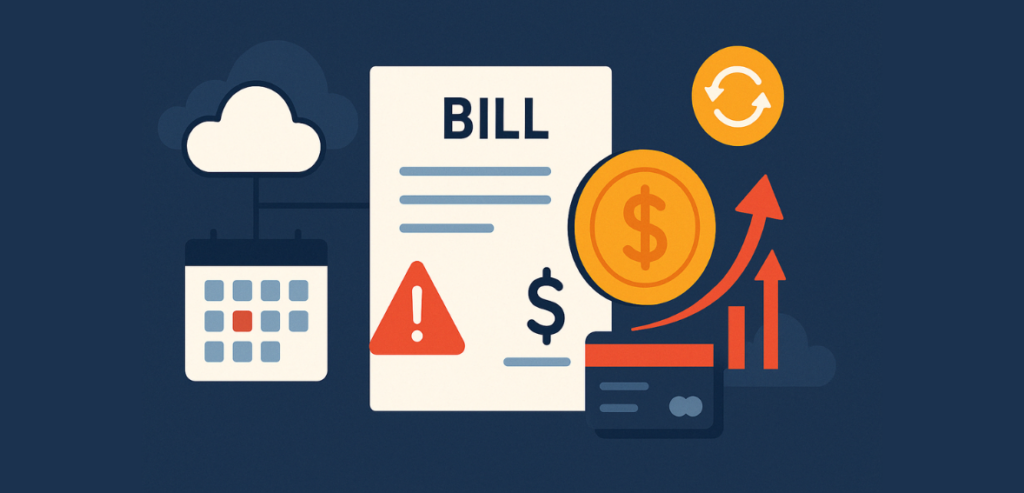
By Lauren Baxter April 16, 2025
Cloud technology has changed the way businesses are managing contracts in addition to jobs and workflows. Contract cloud job management systems provide unparalleled flexibility and efficiency from automating routine tasks to enabling remote collaboration. They help with centralization of contract lifecycles, job progression tracking, and compliance maintenance across the departments, thus helping businesses operate seamlessly. But still, with the increase in adoption, there can be challenges in managing your contract cloud jobs.
Many organizations find that integration of systems, data safety, end-user uptake, and scalability can present problems. But if implementation is not to plan and the right strategy is not used, cloud can be a burden instead of a blessing. No matter your role — project manager, operations lead, IT decision-maker or otherwise — it pays to spot these challenges early on to avoid wasting time, money, and headaches.
This article analyzes the top challenges one faces while managing contract cloud jobs and suggests actionable ways to solve them. The right strategy can allow businesses to leverage the full scale of cloud-based systems while minimizing pitfalls. Let’s get started.
What Is Contract Cloud Job Management?

Contract cloud job management is the use of cloud-based platforms to manage end-to-end contracts and job functions efficiently. This includes creating contracts, executing contracts, monitoring contracts, and assigning jobs.
A company that is managing multiple vendor contracts, for example, can use a cloud-based tool that enables them to designate jobs, timelines and approval processes, and be able to track compliance in real time. Instead of relying on emails, spreadsheets, or physical paperwork, everything is centralized, searchable, and accessible from anywhere.
It typically features the following:
- Contract drafting and template management
- Role-based access and collaboration tools
- Automated job scheduling and notifications
- Real-time progress tracking and analytics
- Audit trails and compliance support
This method is most beneficial for organizations that manage large numbers of contracts or projects over teams, departments, or geographies. But along with the advantages, the businesses are faced with a lot of challenges when it comes to contract cloud job management. Let’s discuss them now.
Challenges Related to Contract Cloud Job Management & Overcoming Them

1. Lack of System Integration
One of the top issues that arise while handling your contract cloud jobs is lack of proper and systemized integration. A lot of organizations use different platforms for finance, human resources, project management and customer support. Silos are formed that hamper business when these systems fail to communicate with each other.
So, one could have something like a contract approved in the cloud system but job details do not get pushed to the HR or payroll tools. This results in a lag, overlaps, or mistakes in execution. Finally, if seamless integration is not ensured then different teams keep shifting between platforms to validate information. This affects productivity and leads to more chances of making mistakes.
Reporting is also hampered by lack of integration. When each department has its own system, businesses end up with no clear picture on projects timelines, contracts status or financial performance. Such a mess could result in missing deadlines or invoicing mistakes or compliance concerns.
To avoid this pitfall, organisations should target cloud platforms that provide open APIs and integration functionality. Choosing tools that sync with existing systems—like Customer Relationship Management, Enterprise Resource Planning, and accounting software—creates a connected workflow. .This saves time, reduces input errors, and helps everyone stay in sync.
This step is more than simply a technical upgrade. It’s essential for removing friction from daily operations and reducing challenges in contract cloud job management as businesses scale.
2. Risks of Data Security and Compliance
Handling sensitive contract data in the cloud raises significant security issues. Contracts often contain personally identifiable information, financial terms, and other sensitive business information. If this information gets out, it could spell disaster — in terms of lawsuits and big financial fines. This is one of the primary reasons data security is amongst the major challenges of managing contract cloud jobs.
Cybercriminals typically target cloud systems for cyberattacks when organizations are often dependent on weak security protocols. They expose sensitive contract data without encryption, access controls, or monitoring tools. A single breach can undo years of work, erode client trust and activate compliance violations.
Another big problem is compliance. Depending on your industry and region, you may need to follow strict regulations like GDPR, HIPAA, or SOC 2. Using a cloud platform whose compliance is not proven can be dangerous to your organization. Penalties and reputational damage can stem from missing audit logs, lack of appropriate access controls, poor data retention policies, etc.
Hence, companies must choose platforms that incorporate security features and compliance. Seek features like end-to-end encryption, multi-factor authentication, periodic security updates, and audit trails. You may consider role-based accessibility (some platforms support this functionality) so that only permitted representatives may view or alter contract facts.
Safeguarding sensitive data is non-negotiable. It’s critical to reducing risk and overcoming the challenges in contract cloud job management in a data-driven world.
3. Low Customization and Scalability

Most of the cloud-based contract management system is a one-size-fits-all model. So this is one of the top challenges in contract cloud job management. Such models come with standard features which may not resonate with a company’s traditional workflows/ job structure. As the necessity changes over time, this turns into a grave problem that limits customization.
A construction company may need milestone-based job tracking, a legal team may be focused on document versioning and approval flows, for example. Teams end up bending their process to the software (instead of the other way around) if the platform prevents custom fields, workflows, user roles and other tools. That creates inefficiencies and user frustration.
The other concern is around scale. Your organization is expanding, so are the number of users, the number of contracts and the number of job types. If a platform is not meant for it, it can struggle with a high volume or complex operations. As you start adding features and users, they get slow, buggy, and costly. These types of struggles are not uncommon in contract cloud job management, particularly among rapidly growing organisations.
Hence, search for solutions that have extensive add-ons to their systems, whether they be workflow builders or drag-and-drop customization, etc. Confirm that if you need to scale up, it won’t cause performance issues or price shock.
Customization and scalability are not nice-to-haves rather they are necessity. They prepare to elevate your growth effort and minimize repetitive management headaches in contract cloud employment.
4. Poor User Adoption and Training Gaps
The best cloud systems can die if users fail to embrace them. One big problem is staff disengagement. This is one of the most common challenges in contract cloud job management, especially during the early implementation phase.
Most platforms have a higher learning curve or a user interface that just doesn’t make sense. When users get confused with the system, they are going to avoid or error. This results in lost updates, partial entries, and disparate job records. Collaboration suffers and productivity falls if only some of the team uses the platform correctly.
Then there are the training gaps that just compound the problem. Businesses either miss out on structured onboarding or look for standard tutorials that do not align with their internal flows. Employees do not know how to use the features effectively and without hand-holding guidance. This frustrates users even more and also causes slow adoption across functions.
The solution? Consider investing in user-friendly platforms with clean and intuitive interfaces. Select systems that include customized onboarding, in-app tutorials and customer assistance. Preferably, look for a platform that offers training by role, so users are only trained on the tools they need.
Effective collaboration is not just a feature—it’s a necessity. So fixing it makes the flow smoother, reduces error and improves collaboration. Tackling training and adoption directly will minimize long-term issues related to contract cloud job execution and also enhance the overall ROI.
5. Lack of Real-Time Collaboration

One of the next challenges in contract cloud job management is lack of collaboration in real-time. Teams today are looking for quick access to contracts, updates, job progress, etc. However, not every cloud platform is designed for seamless real-time collaboration. This leads to delays and confusion and miscommunication. As an example, when many people in a team do contract or job change, there will be sync issues. Without real-time editing or automatic version control, users might overwrite each other’s changes or rely on outdated information. Such mistakes may slow down the projects or cause expensive errors in executing the contracts.
This becomes even more problematic with geographically distributed teams. You can imagine how the absence of collaborative tools can really slow down the processes of approvals, job assignments or document reviews that take place across time zones. Email threads and manual status updates simply won’t cut it – they cause bottlenecks and make it impossible to track who owns what.
Hence, for tackling such challenges in contract cloud job management, businesses need to opt for a platform that allows real-time editing, enables task tracking, comment threads, and automatic notifications. Solutions such as collaborative dashboards, activity logs and mobile access can help keep all the teams up to date and in sync, no matter where they are based or what device they access the information on.
Collaboration is not a feature but a vital part of the play. Addressing these real-time challenges improves team alignment, shortens contract cycles, and lowers friction.
6. Inaccurate Reporting and Limited Analytics
Smart decisions rest on access to accurate data. However, most companies lack the true ability to gain insights from their cloud platforms. Across the board, contract cloud job management can be plagued with issues such as poor reporting tools and minimal analytics capabilities to boost operations– particularly when it comes to scaling.
Managers lose track of contract lifecycles, job performance numbers, and project cost projections without detailed reports. They rely on manual updates or spreadsheets, which are time-consuming and error-prone. The lack of visibility causes missed deadlines, use of resources inefficiently, and delays in making decisions.
There are some platforms that do most of the reporting for you, but it’s typically not very flexible. Users may not be able to establish dashboards, or drill-downs on key metrics such as contract turnaround time, job completion rates, or compliance gaps. That means critical insights get buried and operational blind spots remain hidden.
To solve this, businesses need platforms with built-in business intelligence (BI) tools and customizable reporting features. Look for dashboards that allow users to filter, segment, and visualize data in real time. Automated reports and predictive analytics also help leaders plan better and act faster.
Reporting isn’t just about performance tracking, accurate reporting reduces risk and increases accountability.
7. Cost Overruns and Subscription Complexities

Managing the costs of cloud-based contract job management tools can be a tricky business. So it often leads to unanticipated blow-outs or organizations being locked-in to subscription plans that no longer fit their requirements. This is a major pain point for managing contract cloud jobs, and it can affect your bottom line.
Cloud platforms are initially cheap, with a subscription approach. However, as more people start working on your team or your use-case changes, the costs can come back to bite you pretty aggressively. Additional costs for premium functionality, user seats, storage, or integrations can drive the costs substantially higher than anticipated. This leaves many businesses caught off guard, forced to make last-minute adjustments to their spending.
Subscription models are often complicated. Vendors may have tiered pricing plans, or charge by the user, the feature, or the data used. This can make costs unpredictable and hard to manage, particularly if your consumption varies over time. This often leads to overpaying on unused features on a monthly, quarterly, or annual basis, or even going over budget without ever knowing it in the first place.
What businesses can do to overcome this is to conduct regular audits of their cloud contracts. Know exactly what you are paying for and find where you can optimize usage. Look out for pricing transparency, flexible plans, and usage models. This way, you can avoid hidden charges and maximise your bang for your buck.
8. Future-Proofing and Tech Upgrades
One of the most significant challenges in contract cloud job management is ensuring that your system remains relevant as technology evolves. As artificial intelligence, machine learning, automation, and data analytics come at the forefront of transformation, businesses must adapt quickly to remain competitive. However, many contract management systems lack the flexibility to integrate new technologies or scale with evolving needs.
When cloud platforms are advanced, legacy systems may not function with the newer features or tools. It allows for a situation in which companies are forced to either pay up for expensive enhancements or switch to a completely different platform. Upgrading can be a time-consuming and expensive process, especially if data migration and user retraining are involved.
So to combat this, it is important to align with cloud vendors that focus on innovation and future-proofing. Search for platforms that have a very strong roadmap that will ensure new feature updates, integration with future technologies, and scalability. Select solutions which can aid automation and aI tools, which may optimize complete contract workflows, minimize human error and simplify job management.
By future proofing your solution, it will ensure that your organization is not left behind as new technologies develop.
Conclusion
There are a lot of amazing advantages to using cloud-based contracts and jobs—efficient, accessible, and automated. Even though it has benefits, it has its challenges. It is important to understand the challenges in contract cloud job management. The road to successful cloud-based contract management isn’t always smooth.
The secret to addressing these concerns is simply finding the appropriate platform, emphasizing training and security, and keeping scalability in mind. With solutions that help remove integration hurdles, fulfill customization requirements, and address future-proofing queries, businesses can lay the groundwork for long-term success in managing contract jobs on the cloud.
With the digital world changing constantly, it is imperative to remain nimble and proactive. By overcoming these hurdles, companies will not only reduce time and effort in their contract and job management processes but also be better positioned for future scales, innovations, and competitive advantage.
Frequently Asked Questions
What is contract cloud job management?
Contract cloud job management refers to using cloud-based platforms to manage contracts and associated job workflows. These systems help businesses handle approvals, tracking, compliance, and performance monitoring in one central, accessible place.
How can businesses ensure data security in cloud contract systems?
They should choose platforms with strong encryption, role-based access, regular backups, and compliance with regulations like GDPR or SOC 2. Secure login and audit trails also add extra protection.
Why do companies face integration issues with cloud contract platforms?
Many platforms don’t easily sync with existing systems like CRMs, ERPs, or accounting tools. This lack of integration creates data silos, manual work, and delays—making it a top challenge in contract cloud job management.
What causes poor user adoption in cloud job management tools?
Complex interfaces, lack of proper training, and features that don’t match real workflows often lead to low adoption. Choosing user-friendly platforms and investing in onboarding can solve this.
Can contract cloud platforms scale with business growth?
Yes—but only if the platform is designed for scalability. Look for customizable solutions that can support more users, contracts, and workflows as your organization expands.